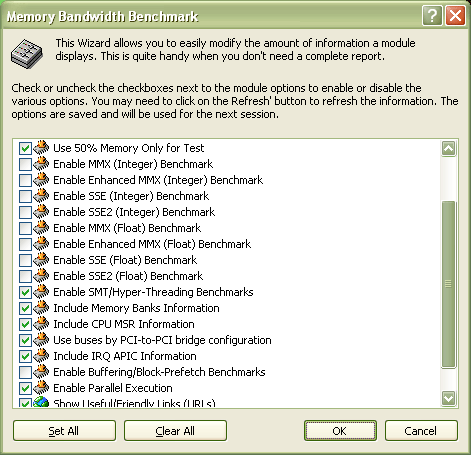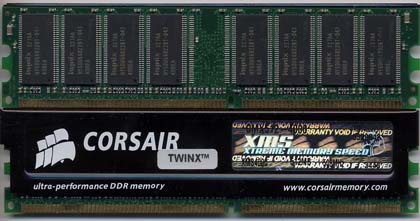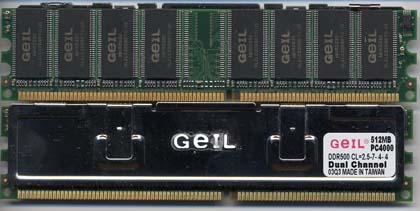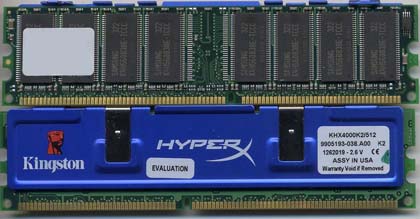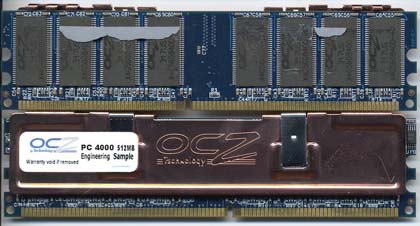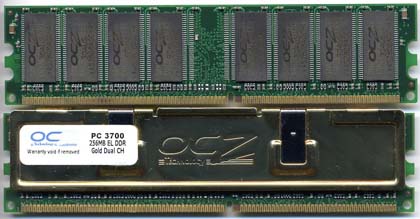
Original Link: https://www.anandtech.com/show/1131
Searching for the Memory Holy Grail - Part 2
by Wesley Fink on August 26, 2003 11:11 PM EST- Posted in
- Memory
We looked for the best performing memory configuration for the 865/875 motherboard in Part 1 of “Searching for the Memory Holy Grail”. In Part 2, we will benchmark the latest high-speed memory, DDR500 and DDR466, to determine how it performs on the Intel 865/875 platform.
When Part 1 was published a few weeks ago, the fastest memory that we had tested was a DDR466 module called OCZ 3700 Gold. It was the first memory we tested to pass the DDR500 mark, which represents a raw bus speed of 250. Since the Pentium 4 bus is quad-pumped, that translates to a Front Side Bus of 1000MHz or ONE GHz — a milestone in FSB speed.
Now, just a few weeks later, we have memory from five manufacturers that claim to run at DDR500. We have even seen a recent announcement from Geil of PC4200 (DDR533) memory. Intel legitimized DDR400 with the 875/865 chipsets, and that is now an official JEDEC standard. These faster memories, however, are basically built to DDR400 specifications, and then tested by their manufacturers to run at the much faster DDR500 speed. There is no official standard yet for DDR500, but all of the manufacturers seem to be using the 875/865 chipset motherboards to verify their high-speed performance. Frankly, there is no real need for DDR500 on the current fastest AMD chipsets — the nForce2 Ultra 400 and VIA KT600 — since neither the chipsets nor the Athlon CPUs have shown any capability of reaching DDR500 performance levels. While this may change with the introduction of Athlon64, the DDR500 and high-speed memory phenomenon is, for now, an Intel chipset playground — primarily related to the Intel 875/865 chipsets.
Things are organized a bit differently in our Part 2 of “Searching for the Memory Holy Grail”. We were forced to modify our testbed in order to better test the performance of the new DDR500 modules. We also added Game performance and Number Crunching benchmarks to Sandra UNBuffered Memory Test to confirm results with real-world benchmarks.
Armed with the fastest memory available from Adata, Corsair, Geil, Kingston, and OCZ, our quest is to find the best performing memory for your Canterwood (875) or Springdale (865) computer.
Test Design
One of the difficulties in testing memory is that most of the memory benchmarks available are synthetic. While synthetic benchmarks can be useful in comparing performance, they can also paint a distorted picture of real-world performance. This is the reason why AnandTech has always preferred benchmarking with real applications. Benchmarks using games are dependent on many system components for their results, including the CPU speed and Video Card, which have a major impact on the final scores. While memory does impact the game benchmark score, it is only one small part of the total score. Finding a game benchmark that is sensitive to memory is not always easy. We discovered Gun Metal 2, for instance, tends to be video-card bound, making it very useful for testing video cards, but not so useful for measuring subtle differences in system performance. After looking at available game benchmarks, we found Quake3 and Unreal Tournament 2003 to be the most useful for our memory testing.
The following Benchmarks were used in our Memory Testing:
1) SiSoft Sandra Max3 UNBuffered Memory Test
Part 1 of “Searching for the Memory Holy Grail” demonstrated the usefulness of the SiSoft Sandra UNBuffered Memory Test as a sensitive benchmarking tool for memory bandwidth. The Sandra UNBuffered Memory Test turns off Memory Buffering schemes in an attempt to improve the measure of raw memory bandwidth. As a result, it also correlates well with bandwidths reported with Memtest86, an industry-standard memory testing tool.The idea of the UNBuffered Memory Benchmark is very simple — you merely turn-off all memory buffering techniques. Sandra makes this very easy to do. Select “Memory Benchmark”, right-click “Module Options”, and uncheck the nine boxes that are related to buffering.
2) SiSoft Sandra Max3 Standard Memory Test
The UNBuffered Memory Benchmarks are quite different from what you may be accustomed to seeing in memory testing with SiSoft Sandra. For reference, we are again including the Sandra Max3 standard Memory Test, sometimes called the Buffered Memory Test.
3) Super PI
Pure number-crunching benchmarks are very useful for measuring system bandwidth. Some of the more popular number-crunchers are the MPEG/DIVX encoding tests, such as the ones that we used in our standard motherboard testing, and Super PI. MPEG/DIVX tests are valuable for a single motherboard benchmark and in cross-platform testing — Athlon vs. Pentium4, for example. However, they are often very sensitive to the test environment or system configuration, and can be difficult to use reliably in an environment that tests a large number of conditions with the same test, such as we will be doing here in our memory testing. Super PI, on the other hand, is very simple to use and has been shown to be less sensitive to the operating system environment. In other words, we don’t have to reinstall the operating system on a clean hard drive each time we run a benchmark just to get reliable numbers.Super PI for Windows 1.1 is a freeware program developed by the Super Computer Consortium at the University of Tokyo. The concept of Super PI is very simple — it calculates the value of pi to “x” number of places, and reports the time this calculation requires. We chose to use 2 million places in our tests. Super PI measures total system bandwidth, and memory is only part of that bandwidth, since the CPU has a significant impact on results. We therefore would expect to see smaller changes in Super PI relative to larger changes in memory-only benchmark tests like Sandra.
4) Quake3 Demo FOUR.dm_66
Quake 3 Demo FOUR is one of our standard game benchmarks. As Evan Lieb showed in his PC3200 memory tests, Quake3 can also reveal variations in memory performance. You will likely be surprised how sensitive Quake3 can actually be in testing wide variations in Memory Speed. We run the benchmark three times, check for score consistency, repeat if we see any wide variation in individual scores, and then average the three scores for the reported Frames per Second (FPS) value.
5) Unreal Tournament 2003 Demo
The Benchmark program built into the UT2003 demo is a contemporary game test that does respond to variations in memory bandwidth. We used it mainly to show the impact of memory speed on UT2003 scores, and to confirm the validity of Quake3 as a real-world test of memory performance. With our new standard ATI 9800 PRO video card, UT2003 shows variation in both Flyby and Botmatch in tests with memory of different speeds. All benchmarks are run at our standard 1024x768 resolution.
Motherboard, CPU, and Peripherals
In Part 1 of “Searching for the Memory Holy Grail”, we used the Abit IC7 for our 875 tests and the Asus P4P800 Deluxe for 865 tests. Because of the impact of PAT on/off at different FSB, we decided to use only the Intel 875 for testing in Part 2. This presented our first problem, since the Abit IC7 has a strange quirk in the way it handles 1:1 memory. No matter what we did, we could not operate the Abit IC7 at greater than a 255 setting (1020FSB). We talked with Abit about this issue, and they are hard at work on a BIOS revision to correct this problem. To be fair, most users will not need to run memory at faster than a setting of 255, and 5:4 and 3:2 memory ratios do not have this issue. However, for our tests here, we expected that we might reach a speed of 275 (1100FSB), and the 255 limitation was not acceptable.Next, we considered the DFI 875PRO LanParty as the motherboard for our testbed. The DFI had no problem handling settings above 255, which corrected that problem. However, as Evan Lieb pointed out in his review of the 875PRO, the vDIMM range to only 2.7V was too limiting for our high-speed memory tests. DFI has told us that they are releasing an updated version of the 875PRO in the near future with expanded vDIMM options. If that were available today, the DFI would have worked well for our testbed.
The latest revision of the ASUS flagship 875 motherboard is the ASUS P4C800-E. This board adds Intel GigaLAN (using the dedicated Intel CSA bus), and incorporates the ICH5R Southbridge with Intel SATA RAID. We will be doing a review update on this new revision of the ASUS flagship Canterwood shortly. The P4C800-E met our requirements of high speed 1:1 operation and a vDIMM adjustment range that was useful. vDIMM is available to 2.85V on the P4C800-E. As a bonus, we were able to use Intel SATA RAID with SATA drives for all testing.
Our 3.0C Pentium 4 800FSB chip was not very useful for testing DDR500 memory. With a maximum overclock of around 245 (980FSB), we could not even reach the rated speed of the memory. We settled on a 2.4C 800FSB Pentium 4 that has been proven to perform very well at high speeds. On the ASUS P4C800-E, this 2.4C was able to reach a stable 288 setting (1152FSB) at default 1.525V, and a setting of 298 (1192FSB) with a modest vCore setting of 1.6V. We were confident that this test setup would allow us to reach the maximum speeds possible with memory rated at a high as DDR500, since we did not anticipate that synchronous operation would exceed DDR596 in our testing.
Since all testing would be done on a single testbed configuration and only compared to test results on that testbed, we chose the best-performing components that we had available. For CPU cooling, we used the Thermalright SLK-900U heatsink with a 120mm adjustable-speed Vantec Tornado cooling fan. The idea here was to remove any concerns about CPU cooling or overclocking ability from the memory test as much as possible. For the video card, we used our new standard ATI Radeon 9800 PRO with 128 MB memory. Hard drives were a pair of Western Digital Raptor 10,000RPM Serial ATA drives running in a SATA RAID 0 (Striping) configuration on the stock Intel ICH5R.
Performance Test Configuration
| Performance Test Configuration | |
| Processor(s): | Intel Pentium 4 2.4GHz (800MHz FSB) |
| RAM: | 2 x 512 MB Adata PC4000 (DS) 2 x 512 MB Corsair PC4000 (DS) 2 x 512 MB Geil PC4000 (DS) 4 x 256 MB Kingston PC4000 (SS) 2 x 512 MB OCZ PC4000 (DS) 4 x 256 MB OCZ PC3700 GOLD (DS) |
| Hard Drives | Two Western Digital Raptor Serial ATA 36.7GB 10,000RPM drives in an Intel ICH5R RAID 0 configuration |
| PCI/AGP Speed | Fixed at 33/66 |
| Bus Master Drivers: | 875P Intel INF Update v5.00.1012, SATA RAID drivers installed, but IAA not installed |
| Video Card(s): | ATI 9800 PRO 128 MB, 128 MB aperture, 1024x768x32 |
| Video Drivers: | ATI Catalyst 3.6 |
| Operating System(s): | Windows XP Professional SP1 |
| Motherboards: | ASUS P4C800-E (875) with 1.010 Release BIOS |
We asked major memory manufacturers to supply DDR500 or the fastest memory that they had available for comparison in our High-Speed memory roundup. Not all manufacturers had DDR500 memory available, and some chose not to supply memory for our testing. All DDR500 memory was supplied by the Manufacturers to AnandTech for testing except Adata PC4000. Instead, Adata supplied DDR450 memory for our roundup. Although it performed very well in our testing, it did not reach our minimum requirement of DDR500 levels of performance, and thus, we did not believe it was fair to include Adata 450 in a roundup of DDR500. The Adata DDR500, however, was located and the retail product was purchased for the review.
Since OCZ 3700 GOLD was the first memory that we tested at AnandTech to have reached DDR500 performance levels, we also included it in our testing. Because the 3700 GOLD allows faster memory timings at some of our tested speeds, it also gave us an opportunity to see the impact of memory timings on test results.
Does Memory Speed really matter in the Real World?
There have been skeptics in the computer industry who have boldly stated that Dual-Channel 266 memory will give performance as fast as you can get — in the real world — with a Canterwood or Springdale motherboard. Another popular variation of this is that memory over DDR400 (PC3200) will make no difference in real-world performance of an 875/865 system. To determine whether these statements held any validity, we decided to first take a look at the influence of memory speed alone on our chosen benchmarks.
We wanted to isolate performance variation as much as possible to Memory. The very design of the Intel 875/865 chipsets makes this difficult, since we have very limited settings for memory ratio. We finally decided to test stock 800FSB settings with different memory speeds, and to also test the highest standard CPU FSB setting we could run at different memory timings. To keep variables at a minimum, we looked at our benchmark results for memory that would perform at both 533 and 400 at the same timings. We settled on two 512 MB DS OCZ 4000 DIMMs. We ran the memory at stock 2.4GHz at 2.5-3-4-6-1 and at a high overclock of 1066FSB at the same 2.5-3-4-6-1 timings. Since we required 2.75V for stable operation at 1066FSB at these timings, we decided for consistency to set the vDimm to 2.75V for all tests. At each setting, we varied only the memory speed at the available 1:1, 5:4, and 3:2 ratios.
Double-Sided Memory
| Standard 800FSB (2.4Ghz) Performance at Varied Memory Speeds — 2 x 512 MB DS DIMMs |
||||||
| Memory DDR Speed | Quake3 fps | UT2003 Flyby fps | UT2003 Botmatch fps | Sandra UNBuffered | Sandra Standard Buffered | Super PI 2M places (time in sec) |
| 266 MHz | 300.30 | 188.66 | 65.55 | INT 1854 FLT 1814 |
INT 3759 FLT 3787 |
144 |
| 320 MHz | 313.70 | 193.26 | 67.57 | INT 2138 FLT 2123 |
INT 4254 FLT 4256 |
138 |
| 400 MHz | 328.07 | 198.27 | 69.16 | INT 2594 FLT 2640 |
INT 4700 FLT 4724 |
132 |
| 1066FSB (3.2GHz) Performance at Varied Memory
Speeds — 2 x 512 MB DS DIMMs |
||||||
| Memory DDR Speed | Quake3 fps | UT2003 Flyby fps | UT2003 Botmatch fps | Sandra UNBuffered | Sandra Standard Buffered | Super PI 2M places (time in sec) |
| 355 MHz | 382.67 | 235.82 | 85.13 | INT 2415 FLT 2394 |
INT 5043 FLT 5039 |
107 |
| 426 MHz | 403.56 | 239.96 | 87.82 | INT 2924 FLT 2875 |
INT 5711 FLT 5688 |
104 |
| 533 MHz | 424.5 | 249.24 | 91.53 | INT 3532 FLT 3542 |
INT 6308 FLT 6252 |
100 |
Since there is much confusion about when and whether Intel’s PAT is activated, and its effect on performance, each setup was checked with CPU-Z 1.18C. Under the “Memory”’ tab, with this version of CPU-Z, there is a box for “Performance Mode”, which will indicate “enabled” or “disabled”.
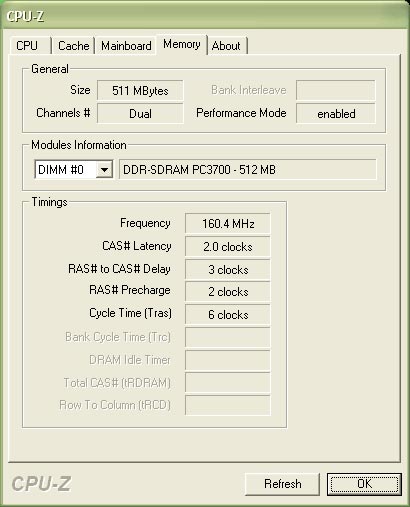
In all configurations, except one, with the ASUS P4C800-E with 800FSB or higher selected, both Synchronous and Asynchronous, CPU-Z indicated Performance Mode “enabled”. We will talk more about the exception later.
As you can clearly see from the tables above, gaming performance continues to improve as memory gets faster on the Intel 875 motherboard. As we move from an 800FSB CPU running 266 memory to the CPU running the same speed with DDR400 memory, we see Quake3 frame rate increase a bit over 9%, while UNBuffered Sandra increases about 40% in memory bandwidth. At 1066 constant CPU speed with memory increasing from 355 to 533, we see a larger increase of 11% in Q3 frame rate, while Sandra UNBuffered increases about 46%. The increase in Quake3 frame rate from 800/266 to 1066/533 — which admittedly includes a large boost in CPU speed — is significant, at 41%.
UT2003 also shows a similar pattern of increases over the same range, with increases over the whole range of 32%-39%. Sandra UNBuffered measurement of memory bandwidth shows a 90% increase over the same range from 800/266 to 1066/533. As we would expect, both UT2003 and Quake3 appear to respond more to a CPU speed increase than a memory increase, but alone, the increases in game benches from memory speed increases are real and significant.
Our pure number-crunching benchmark, Super PI, is shown to be more sensitive to memory speed than you might expect. We saw increases of 7% to 9% in the “memory only” increases at a fixed CPU speed. These increases are only a little smaller than those found in our Quake3 tests.
It is conclusive from these benchmarks that Memory Speed does matter in real-world performance on Intel 875/865 motherboards. Game benchmarks, Super PI, and Sandra Memory Tests all benefit from increases in memory speed. This was true up to the highest memory speed that we tested — DDR533. The differences, when we looked at just the effect of memory alone, varied from 9% to 11% at a given CPU speed, with the limited memory ratios Intel has provided us on the 875/865 chipsets. You will have to decide if the increases in performance from using faster memory are worth the cost of that speedier memory. For some, these increases will matter a great deal, while for others, they will not be worth the cost.
Memory Configuration (continued)
Our benchmarks in Part 1 were consistent with the configuration recommendations in the Intel White Papers for Memory Configuration of the 875 and 865 chipsets. We concluded with the following performance charts based on our testing and the information provided by Intel. We differ from the Intel White Paper charts only in the first and second positions for the Intel 865 chipset. When Intel published their White Papers, we doubt that they had any notion that most of the 865 motherboards being sold would have some version of PAT (Performance Acceleration Technology) on board. Our testing of the ASUS, AOpen, and DFI PAT-enabled boards shows that the PAT 865 boards behave more like 875 boards. We have confirmed that the first and second positions on PAT-enabled 865 boards are, as we report, below — with four DS DIMMs performing faster than two DS DIMMs.
| DDR400 (1:1) Performance | DIMM Configuration | Single-Channel or Dual-Channel |
| 1 | 4 DS | Dual Channel |
| 2 | 2 DS or 4 SS | Dual Channel |
| 3 | 2 SS | Dual Channel |
| 4 | 4 SS/DS Mixed Matched Pairs |
Dual Channel |
| 5 | Any DS | Single Channel |
| 6 | Any SS | Single Channel |
| DDR333/266 Performance | DIMM Configuration | Single-Channel or Dual-Channel |
| 1 | 2 DS or 4 SS | Dual Channel |
| 2 | 2 SS | Dual Channel |
| 3 | 4 DS | Dual Channel |
| 4 | 4 SS/DS Mixed Matched Pairs |
Dual Channel |
| 5 | Any 1 or 2 DS or SS (1 DIMM or 1 in each Channel) |
Single Channel |
| 6 | Any 1 SS | Single Channel |
While SiSoft Sandra UNBuffered Memory Test results demonstrated real differences in performance among these memory configurations, many of you asked what we might see in real-world performance differences with these different memory configurations.
Some of the configurations were easier to test than others. Kingston had provided us with four Single-Bank (single-sided) DDR500 DIMMs that allowed us to look at performance differences in two SS DIMMs versus four SS DIMMs. We looked at performance of 1000FSB/DDR500 at 3-4-4-7-1 memory timings at 2.65V.
| 1000FSB (3.0GHz)/DDR500 Performance — Kingston PC4000 2 x 256 MB SS DIMMs vs. 4 x 256 MB SS DIMMs |
||||
| Number of Single-Bank DIMMs | Quake3 fps |
Sandra UNBuffered | Sandra Standard Buffered |
Super PI 2M places (time in sec) |
| 2 | 386.30 | INT 2821 FLT 2786 |
INT 5830 FLT 5748 |
109 |
| 4 | 394.57 | INT 3218 FLT 3195 |
INT 5841 FLT 5818 |
107 |
While the differences in Quake3 frame rate and Super PI times are small, keep in mind that the only change here is using four SS DIMMs instead of two SS DIMMs. As predicted by Sandra UNBuffered Memory Test, the four SS DIMMs perform better than two SS DIMMs.
Comparing two SS DIMMs to two DS DIMMs was done using 2 x 256 MB SS OCZ PC4000 and 2 x 512 MB DS PC4000 at timings of 2.5-3-4-6 at 2.65V. It is almost impossible to keep DIMM capacity the same, which would be the most accurate test, as none of the samples using the same memory chips would have the same exact capacity in SS and DS configurations.
| 1000FSB (3.0GHz)/DDR500 Performance — OCZ PC4000 2 x 256 MB SS DIMMs vs. 2 x 512 MB DS DIMMs |
||||
| Number of DIMMs & Configuration | Quake3 fps |
Sandra UNBuffered | Sandra Standard Buffered |
Super PI 2M places (time in sec) |
| 2 SS | 392.30 | INT 2918 FLT 2926 |
INT 5761 FLT 5868 |
109 |
| 2 DS | 400.10 | INT 3282 FLT 3324 |
INT 5965 FLT 5934 |
106 |
Again, the differences are small but real in Quake3 and Super PI, but with 2 DS DIMMs performing better as we had demonstrated in Part 1 with the Sandra UNBuffered Memory Test.
The fastest configuration should be 4 Double-Bank DIMMs on the Intel 875 chipset motherboard. Our first efforts to test this configuration, with 4 x 256 DS OCZ 3700 GOLD modules did not show 4 DS DIMMs any faster than 2 DS DIMMs on the ASUS P4C800-E. This was a real puzzle considering that other predicted configurations were easily verified with Quake3, Super PI and other benchmarks. When we looked deeper, the problem became clear. In every configuration that we had tested with the ASUS P4C800-E, the Performance Mode showed “enabled” but with 4 DS DIMMs at any FSB speed faster than 800, CPU-Z 1.18C shows Performance Mode “disabled”. Our trial was failing here because we were comparing 2 DS DIMMs with PAT on to 4 DS DIMMs with PAT off. We have asked ASUS for the reason behind why PAT appears to be disabled at 4 DS DIMMs above 800FSB.
Since we were mainly concerned with comparing 2 DS with 4 DS DIMMs under the same conditions, we ran 2 DS vs. 4 DS tests at 800FSB/DDR400, so that PAT was enabled in both two and four DIMM setups. We compared prototypes of high-speed PC3700 memory that we tested, looking specifically at the performance of 2 x 512 MB DS to 4 x 512 MB DS at DDR400. Timings were 2-2-4-8 at 2.75V.
| 800FSB (2.4GHz)/DDR400 Performance 2 x 512 DS vs. 4 x 512 DS |
||||||
| Number of DS DIMMs | Quake3 fps |
UT2003 Flyby fps |
UT2003 Botmatch fps |
Sandra UNBuffered | Sandra Standard Buffered |
Super PI 2M places (time in sec) |
| 2 | 321.4 | 196.30 | 68.31 | INT 2683 FLT 2722 |
INT 4704 FLT 4691 |
133 |
| 4 | 324.5 | 197.60 | 69.38 | INT 2830 FLT 2923 |
INT 4678 FLT 4717 |
132 |
While the differences here are quite small, they still show 4 DS modules performing better than 2 DS modules. We suspect that we would see larger differences at higher speed, as we have in our other comparisons.
We have confirmed with game benchmarks and a number-crunching benchmark that the best 875/865 memory configurations can also be seen in real-world benchmarks. Because memory performance is only one component of game performance and overall system bandwidth, the effect on these benchmarks is, as expected, smaller than the variation seen in benchmarks that measure only memory performance, like Sandra UNBuffered Memory Test.
The Candidates
With what we know now about 875/875 memory configurations, the ideal test of the fastest memory available would be four double-bank modules. However, not all memory manufacturers had DS DDR500 modules available. Therefore, to be fair in our memory comparison, we asked memory vendors, at the very minimum, to supply 2 DS DIMMs or 4 SS modules of their fastest memory for evaluation. Over several weeks, we received PC4000/DDR500 samples from Corsair, Geil, Kingston, OCZ and Adata. OCZ 3700 Gold was also included in the roundup, since it is known to perform at DDR500.
| DDR500 Memory Specifications | ||||||
| Adata PC4000 | Corsair XMS 4000 | Geil Platinum 4000 | Kingston HyperX 4000 | OCZ 4000 Copper | OCZ 3700 Gold | |
| Number of DIMMs & Banks | 2 DS | 2 DS | 2 DS | 4 SS | 2 DS | 2 DS |
| DIMM Size Total Memory | 512 MB 1 GB |
512 MB 1 GB |
512 MB 1 GB |
256 MB 1 GB |
512 MB 1 GB |
256 MB 512 MB |
| Rated Timings | 3-4-4-8 | 3-4-4-8 | 2.5-4-4-7 | 3-4-4-8 | 3-4-4-7 | 2.5-3-3-7 @DDR466 |
| Rated Voltage | ? | 2.75V | 2.6-2.95V | 2.65V | 2.7V | 2.65V @DDR466 |
With each set of DDR500 memory, we tested at the following settings:
1. 800FSB/DDR400 – the highest stock speed supported on 875/865 motherboards.To test overclocked stability, we used a run of the very demanding Gun Metal 2 — Benchmark 2, which pushes systems with its demanding DX9 routines. To be considered stable for test purposes, Gun Metal, our Quake3 benchmark, UT2003 Demo, and Super PI had to complete without incident. Any of these four, and in particular Super PI and Gun Metal, will crash a less-than stable memory configuration.
2. 1000FSB/DDR500 – the specified rating of the memory modules that we were testing.
3. Highest Stable Overclock – the highest settings that we could achieve with the memory being tested.
Adata PC4000
Click the image to view a larger picture.
Adata DDR500 is a very reasonably-priced DDR500, but somewhat difficult to find in the US market. It is readily available and widely used in many Asian markets. It was the only DDR500 tested in this roundup which was not supplied as a Dual-Channel kit. The DIMMs are packaged without heatspreaders, and labeled are assembled from blanks that carry an Adata ID.
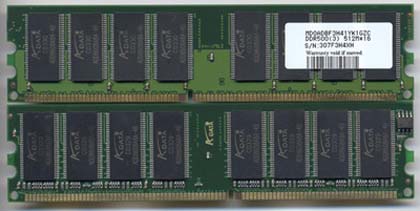
The Adata performed well at DDR500, but our samples were some of the poorer overclockers in our DDR500 roundup.
| Adata PC4000 — 2 x 512 MB Double-Bank | |||||
| Speed | Memory Timings & Voltage | Quake3 fps |
Sandra UNBuffered | Sandra Standard Buffered | Super PI 2M places (time in sec) |
| 400DDR 800FSB |
2.5-3-3-6 2.55V |
326.47 | INT 2655 FLT 2624 |
INT 4704 FLT 4745 |
133 |
| 500DDR 1000FSB |
3-4-4-8 2.65V |
394.37 | INT 3143 FLT 3172 |
INT 5806 FLT 5905 |
107 |
| 518DDR 1036FSB |
3-4-4-8 2.85V |
408.60 | INT 3459 FLT 3394 |
INT 6093 FLT 6111 |
103 |
Corsair XMS4000
Click the image to view a larger picture.
Corsair DDR500 carries the XMS label, which Corsair uses for their high-performance memory. Modules are packaged with the Corsair trademark low-luster black aluminum heatspreaders and are supplied as a matched pair in a TwinX kit. Corsair uses Hynix chips in their DDR500 — the same chips used by OCZ and Geil.
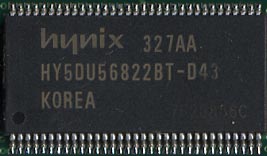
Corsair has a reputation for reliably meeting or exceeding their performance specifications, and their XMS4000 performed well at DDR500, overclocking to a stable DDR530. While this is excellent performance, we were a bit surprised that the other Hynix chip entries — OCZ and Geil — both overclocked to significantly higher speeds than Corsair. Other reviews that we have seen of Corsair XMS4000 are showing very similar overclocks to what we found, so DDR530 appears to be a typical overclock for Corsair XMS4000.
| Corsair XMS4000 — 2 x 512 MB Double-Bank | |||||
| Speed | Memory Timings & Voltage | Quake3 fps |
Sandra UNBuffered | Sandra Standard Buffered | Super PI 2M places (time in sec) |
| 400DDR 800FSB |
2.5-3-4-5 2.55V |
319.63 | INT 2636 FLT 2647 |
INT 4702 FLT 4740 |
132 |
| 500DDR 1000FSB |
2.5-3-4-6 2.65V |
400.20 | INT 3215 FLT 3246 |
INT 5961 FLT 5951 |
107 |
| 530DDR 1060FSB |
3-4-4-8 2.85V |
417.43 | INT 3420 FLT 3443 |
INT 6263 FLT 6216 |
101 |
Geil Platinum 4000
Click the image to view a larger picture.
Geil (pronounced Gale, as in gale-force winds) Platinum series DDR500 comes in the fanciest Dual-Channel kit packaging that we have seen. The matched pair of dual-channel modules is in a slide-top Plexiglas presentation case. Modules are packaged with the high-shine platinum-colored heatspreaders with the high-relief Geil logo. Geil uses blanks that are labeled with a Geil ID on the chips. While we do not have confirmation from Geil, the chips behave like Hynix in their timings and performance — the same chips used by OCZ and Corsair.
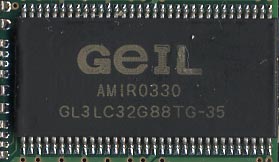
Geil was the biggest surprise in this roundup, performing very well at all tested speeds, and coming in at a close 2nd at DDR546 for highest stable overclock.
| Geil Platinum 4000 — 2 x 512 MB Double-Bank | |||||
| Speed | Memory Timings & Voltage | Quake3 fps |
Sandra UNBuffered | Sandra Standard Buffered | Super PI 2M places (time in sec) |
| 400DDR 800FSB |
2.5-3-4-5 2.55V |
321.53 | INT 2612 FLT 2646 |
INT 4701 FLT 4710 |
133 |
| 500DDR 1000FSB |
2.5-3-4-6 2.65V |
399.8 | INT 3336 FLT 3348 |
INT 5932 FLT 5890 |
107 |
| 546DDR 1092FSB |
3-4-4-8 2.85V |
429.13 | INT 3439 FLT 3507 |
INT 6469 FLT 6455 |
98 |
Kingston HyperX 4000
Click the image to view a larger picture.
Kingston is one of the largest memory manufacturers, and they use the HyperX name for their highest performing memory modules. The trademark bright blue aluminum heatsinks immediately identify the memory as Kingston HyperX. HyperX 4000 is supplied in a Dual-Channel kit. The modules that were sent are the only single-sided DDR500 modules that we received, and as requested, Kingston supplied two pairs of modules for testing. Kingston uses Samsung TCCC chips, which are binned for performance — the highest performers going into HyperX 4000 modules.
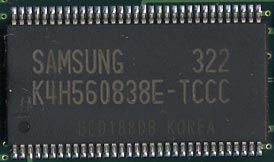
The Kingston modules performed well when 4 SS DIMMs were used for testing. This was expected. As you can see below, 2 SS DIMMs did not perform quite as well, which is consistent with the information in Intel White Papers. The Intel 875P Chipset Memory Configuration Guide White Paper is available at ftp://download.intel.com/design/chipsets/applnots/25273001.pdf, and the Intel 865P Chipset Memory Configuration Guide White Paper at ftp://download.intel.com/design/chipsets/applnots/25303601.pdf.
We were very surprised when we compared overclocking of 2 SS DIMMs versus 4 SS Kingston modules. We tried both pairs of SS memory, but could not overclock any higher than DD514. However, with all four of the same DIMMs, we reached a DDR535 overclock.
Early revisions of HyperX 4000 from Kingston met their specifications of DDR500 and did run at rated speed. However, they were very poor overclockers, regardless of configuration. Later revisions supplied by Kingston overclocked much better, and were used for Kingston testing in this roundup.
| Kingston HyperX 4000 — 4 x 256 MB Single-Bank | |||||
| Speed | Memory Timings & Voltage | Quake3 fps |
Sandra UNBuffered | Sandra Standard Buffered | Super PI 2M places (time in sec) |
| 400DDR 800FSB |
2.5-3-3-6 2.55V |
324.30 | INT 2589 FLT 2671 |
INT 4808 FLT 4745 |
131 |
| 500DDR 1000FSB |
3-4-4-7 2.65V |
394.57 | INT 3218 FLT 3195 |
INT 5841 FLT 5905 |
107 |
| 535DDR 1070FSB |
3-4-4-8 2.85V |
421.33 | INT 3459 FLT 3344 |
INT 6093 FLT 6111 |
100 |
| Kingston HyperX 4000 — 2 x 256 MB Single-Bank | |||||
| Speed | Memory Timings & Voltage | Quake3 fps |
Sandra UNBuffered | Sandra Standard Buffered | Super PI 2M places (time in sec) |
| 400DDR 800FSB |
2.5-3-3-6 2.55V |
320.13 | INT 2514 FLT 2500 |
INT 4735 FLT 4757 |
132 |
| 500DDR 1000FSB |
3-4-4-7 2.65V |
386.30 | INT 2821 FLT 2786 |
INT 5830 FLT 5748 |
109 |
| 514DDR 1028FSB |
3-4-4-8 2.85V |
396.77 | INT 2835 FLT 2864 |
INT 5923 FLT 6010 |
106 |
OCZ 4000 Copper
Click the image to view a larger picture.
OCZ 4000 was supplied with copper-colored heatspreaders. OCZ names their memory by the heatspreader color, so we have names like OCZ 3700 Gold, 3500 Platinum, and 4000 Copper. Since the Platinum name is usually reserved for the lowest latency modules, we can hope that we’ll be seeing a low-latency DDR500 some time in the future. The 512 MB modules were supplied in a Dual-Channel kit. Like Geil, OCZ uses chip blanks, which are labeled with the OCZ ID and speed rating. OCZ has confirmed that Hynix blanks are used in producing OCZ 4000.
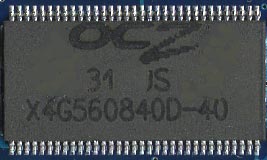
We do not know exactly how OCZ achieved such incredible overclocking with their PC4000 memory, but we were able to attain an overclock of DDR552 in our testing. At lower speeds, the performance of OCZ 4000 is very comparable to Corsair and Geil, which also use Hynix chips in their modules. We did a quick scan of other reviews of OCZ 4000 to see if our results were in-line, and we found others who were also finding high overclocks in the same range with OCZ 4000. This is the first memory that we have tested that passes 1100FSB.
| OCZ 4000 Copper — 2 x 512 MB Double-Bank | |||||
| Speed | Memory Timings & Voltage | Quake3 fps |
Sandra UNBuffered | Sandra Standard Buffered | Super PI 2M places (time in sec) |
| 400DDR 800FSB |
2.5-3-4-5 2.55V |
319.67 | INT 2620 FLT 2657 |
INT 4701 FLT 4742 |
132 |
| 500DDR 1000FSB |
2.5-3-4-6 2.65V |
400.10 | INT 3282 FLT 3324 |
INT 5965 FLT 5934 |
106 |
| 552DDR 1104FSB |
3-4-4-8 2.85V |
435.27 | INT 3513 FLT 3617 |
INT 6468 FLT 6505 |
97 |
OCZ 3700 Gold
Click the image to view a larger picture.
A few weeks ago, when we first starting talking about a review of high-speed memory, OCZ 3700 Gold was the only memory that we had tested to reach DDR500 performance levels. Within those few short weeks, we find five manufacturers who have produced memory that reaches the DDR500 performance level and beyond. As we reported earlier, OCZ 3700 Gold uses Samsung TCB3 chips, which are lasered to improve heat dissipation/performance, and are labeled with a new OCZ ID and speed rating.
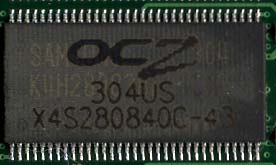
While OCZ 3700 GOLD is now out-performed at the top end by several of the tested DDR500 brands, it competes very well against DDR500 memory. It also uses faster timings than any of the PC4000 modules, which makes it the fastest memory in our DDR400 and DDR500 memory tests. If you have a higher speed Pentium 4 800FSB CPU, like the 2.8C, 3.0C, or 3.2C, then memory with faster memory timings, like 3700 Gold, will likely give you the best performance.
| OCZ 3700 Gold — 2 x 256 MB Double-Bank | |||||
| Speed | Memory Timings & Voltage | Quake3 fps |
Sandra UNBuffered | Sandra Standard Buffered | Super PI 2M places (time in sec) |
| 400DDR 800FSB |
2-2-3-6 2.55V |
328.07 | INT 2840 FLT 2852 |
INT 4821 FLT 4789 |
130 |
| 500DDR 1000FSB |
2.5-3-3-7 2.75V |
406.27 | INT 3396 FLT 3369 |
INT 5891 FLT 5943 |
105 |
| 528DDR 1056FSB |
2.5-3-4-7 2.85V |
420.4 | INT 3467 FLT 3518 |
INT 6297 FLT 6317 |
100 |
Performance Tests
All of the memory in our round-up was compared at both DDR500 — the rated speed for most of the modules — and the highest stable overclock achievable that would run Gun Metal 2 Benchmark 2, Quake 3, UT2003, and Super PI to 2MM places.Results are compared for Quake 3, Sandra UNBufferred Memory Test, and Super PI. The SiSoft Sandra reports two results for each memory test — and Integer value and a Float value. We considered adding the results together for our tests, but felt it might be difficult to compare to other Sandra UNBuffered test results. Results reported in our charts are the result of averaging the INT and FLOAT scores, which are normally close in value. In essence, INT and FLOAT scores were added and divided by two for our reported score.
DDR500 Test Results
Highest Memory Speed Results
Final Words
All of the modules that we tested performed very well at DDR500. If you plan to only run your new DDR500 at rated speed, then any of the memory we tested will meet your needs: Adata PC4000, Corsair XMS4000, Geil Platinum 4000, Kingston HyperX 4000, OCZ 4000, and OCZ 3700 Gold. Keep in mind that your CPU must be capable of running at a raw 250FSB or 1000FSB to run your memory at DDR500. The higher-speed Pentium 4 CPUs — the 2.8C, 3.0C, or 3.2C — cannot usually reach this bus speed and you will likely be running your memory at less than DDR500 speed. Many 2.4C and 2.6C CPUs that we have tested can run at DDR500. The new DDR500 memory is an excellent match for these processors.
Among the DDR500 group, the very different behavior of 2 Single-Bank Kingston HyperX 4000 compared to 4 Single-Bank would recommend that you buy four single-sided modules for best performance and overclocking if you choose single-bank modules for DDR500.
At DDR500 and DDR400, the fastest memory performance was found with OCZ 3700 Gold, because the memory supports faster timings than other memory tested here. The OCZ 3700 Gold ran at very fast 2-2-3-6 timings at DDR400, but still overclocked to DDR528 at 2.5-3-4-7 timings at 2.85V. For faster P4s, the OCZ is an excellent choice that will give you the headroom for the best overclock possible with your CPU, while still providing faster timings for the DDR400 range. Kingston and Adata also performed well with fast timings at DDR400, and would also be good choices for a higher-speed Pentium 4. The Adata PC4000 is selling at very low prices compared to the premium brands that we tested here; and while it is not the best overclocker, it certainly does perform to DDR500 and beyond. Adata is, however, difficult to find in the US.
The modules using Hynix memory were the best performers at the very highest speeds. Corsair, OCZ and Geil were all at the top of the performance charts from DDR500 to the highest overclock that they could achieve. But the top two here — OCZ 4000 and Geil Platinum 4000 — reached significantly higher overclocks than Corsair and turned in the highest performance numbers in our round-up.
You will find variation in performance of memory modules, and thus, we cannot guarantee that your memory purchase will achieve the same performance levels as stated in this review. However, we are truly astounded by the ability of OCZ 4000 Copper to perform at DDR 552, the fastest memory that we have tested thus far. If your CPU can handle a raw 275 bus speed (and a few can), then OCZ 4000 will provide synchronous memory performance at levels that we could only imagine a short time ago.

